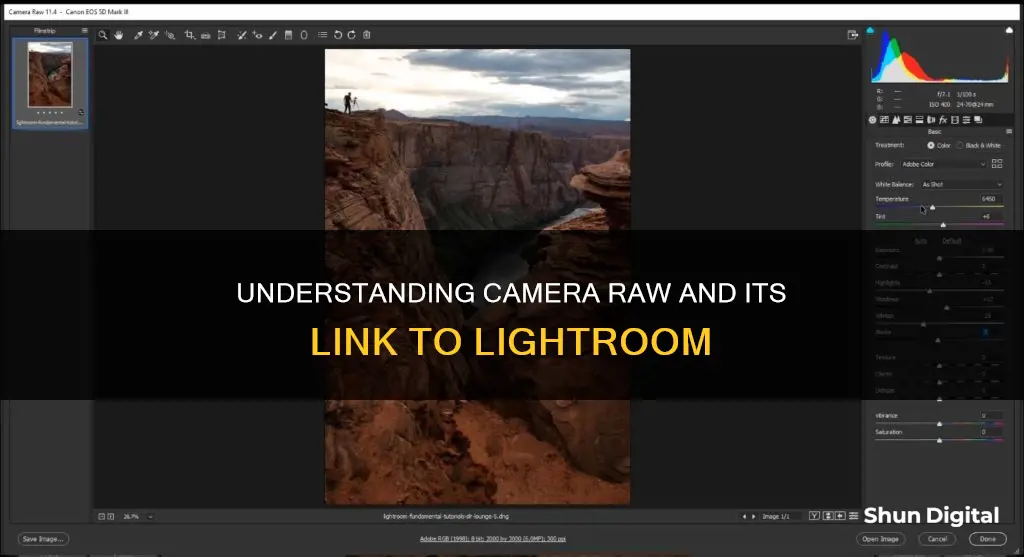
Adobe Camera Raw (ACR) and Lightroom are two of the most popular photo editing software options. ACR is a plugin that requires a host program like Photoshop, Photoshop Elements, Bridge, or After Effects. Lightroom, on the other hand, is a standalone program that doesn't need a host. While both tools share similarities in their interfaces and editing capabilities, they also have notable differences in terms of functionality, file management, and integration with other software.
| Characteristics | Values |
|---|---|
| Image editing workspace | Camera Raw's workspace is similar to Lightroom's Develop Module. |
| Image editing results | Both Camera Raw and Lightroom produce the same image results. |
| File formats | Camera Raw supports most raw file formats, as well as JPEG and TIFF. |
| File management | Camera Raw does not have a system for cataloguing and organisation. |
| Batch editing | Camera Raw allows batch editing, but only if selected at the beginning. |
| Video editing | Camera Raw can be used to edit videos inside Photoshop CC. |
| Access | Camera Raw is not a standalone program and must be used through another Adobe app, such as Photoshop, Photoshop Elements, Bridge, or After Effects. |
| Interface | Camera Raw's interface is similar to Lightroom's but has fewer tabs and the tools for healing, cropping, etc. are located on the side. |
| Cost | Camera Raw is included in Adobe's Creative Cloud packages for Photoshop or After Effects. |
What You'll Learn
- Adobe Camera Raw (ACR) is a plugin that needs to be hosted by another program like Photoshop, Photoshop Elements, Bridge, or After Effects
- Lightroom is a standalone program with a user-friendly interface and a smaller learning curve than ACR
- ACR supports most raw file formats and can also process JPEG and TIFF files
- Lightroom supports most RAW formats, HEIF, TIFF, JPEG, PSD, PSB, CMYK, PNG, and some video formats
- ACR edits are stored in .XMP files, while Lightroom stores edits in a single LRCAT file

Adobe Camera Raw (ACR) is a plugin that needs to be hosted by another program like Photoshop, Photoshop Elements, Bridge, or After Effects
Photoshop cannot directly open Raw files, so another program is needed to decode the files, and this is where ACR comes in. ACR decodes these files into a format that Photoshop can read. Raw images are uncompressed digital image files, like undeveloped film, and contain all the information collected by a digital camera.
ACR can also be launched midway through your workflow in Photoshop as a filter. When you open a Raw file with Photoshop, it will automatically launch ACR. You can also use ACR as a filter at any time while in Photoshop. ACR can be used to process other file formats such as JPEG and TIFF.
ACR can be used with Adobe Bridge, which is a file browser that you can use to manage all the files on your hard drive. Bridge supports all sorts of file formats and gives access to more than one person at a time, making it great for collaborative work in big teams. When you open a Raw file from Bridge, it will automatically launch ACR.
ACR is included as standard with a subscription to any of Adobe’s Creative Cloud packages that include either Photoshop or After Effects. You cannot buy or subscribe to ACR on its own.
Charging Your Roku Doorbell Camera: A Step-by-Step Guide
You may want to see also

Lightroom is a standalone program with a user-friendly interface and a smaller learning curve than ACR
Lightroom is a one-program solution, whereas ACR needs another software program to host it. This makes Lightroom more accessible and easier to use, especially for those new to photo editing. The interface is intuitive, and the learning curve is gentle.
Lightroom also has more advanced search features than ACR. This is particularly useful as your photo library grows and you want to keep things organised. With Lightroom, you can add presets, view your editing history, and easily navigate the pictures you are editing. You can also choose to view other pictures in your library and decide whether to start editing.
Lightroom is also a great choice if you want to edit your images and then import them into Photoshop for further adjustments. Lightroom can save your images as PSD files, so you don't need to import photos from Photoshop to ACR.
Lightroom is a powerful, user-friendly program that is an excellent choice for photographers, whether beginners or professionals. It has a comprehensive set of tools and features that make it a popular and effective photo editing solution.
Vivint's Outdoor Camera: Battery-Powered Wireless Security
You may want to see also

ACR supports most raw file formats and can also process JPEG and TIFF files
Adobe Camera Raw (ACR) is a program designed by Adobe to develop RAW files. It can be supported by Photoshop, Photoshop Elements, Bridge, and After Effects. ACR supports most raw file formats and can also process JPEG and TIFF files.
RAW files are uncompressed digital image files that contain all the information collected by a digital camera. They are like undeveloped films, and all edits made to them are non-destructive. This means that the raw file stays the same, and any edits are saved in a separate file.
When you open a RAW file with Photoshop, it will automatically launch Adobe Camera Raw. Camera Raw can also be launched midway through your workflow in Photoshop as a filter.
JPEGs, on the other hand, are compressed image files. Your camera applies settings like white balance and colour saturation to the image and post-processes JPEGs by removing unused information.
TIFF files are also image files that can be processed by ACR.
Bridge and Camera Raw: The Perfect Pairing
You may want to see also

Lightroom supports most RAW formats, HEIF, TIFF, JPEG, PSD, PSB, CMYK, PNG, and some video formats
Lightroom supports a wide range of image formats, including most RAW formats, HEIF, TIFF, JPEG, PSD, PSB, CMYK, PNG, and some video formats. This versatility makes it a powerful tool for photographers and designers who work with various file types.
RAW formats are supported by Lightroom, which can process and interpret raw image data from most camera manufacturers. This is especially useful since most cameras save image data in their proprietary raw formats. Lightroom's ability to handle raw files means photographers can import and work with these files seamlessly.
Additionally, Lightroom supports the Digital Negative (DNG) format, which is an open standard for raw files. This ensures that photographers can access and use their raw files in the future without being locked into a specific camera system.
TIFF files are also supported by Lightroom, including 8-bit, 16-bit, and 32-bit versions. TIFF is a flexible bitmap image format that is widely used for exchanging files between different applications and computer platforms.
For colour images, Lightroom supports the JPEG format, which is commonly used for displaying photographs online and in presentations. JPEGs are compressed, which reduces file size but may result in some loss of quality.
Lightroom also works with PSD, the standard Photoshop file format. To import and edit PSD files with multiple layers in Lightroom, they must be saved in Photoshop with the "Maximize PSD and PSB File Compatibility" preference turned on.
Large Document Format (PSB) is also supported by Lightroom Classic, allowing for documents up to 65,000 pixels in length and a maximum dimension of 512 megapixels. Similar to PSD files, PSB files require the "Maximize PSD and PSB File Compatibility" preference to be enabled in Photoshop for successful import and editing in Lightroom.
While Lightroom primarily handles still image formats, it also supports some video formats. This allows photographers and videographers to work with a range of media within the same software, streamlining their workflow.
Polaroid Land Camera: Battery Power for Instant Photos
You may want to see also

ACR edits are stored in .XMP files, while Lightroom stores edits in a single LRCAT file
When it comes to storing edits, Adobe Camera Raw (ACR) and Lightroom differ in their approach. ACR edits are stored in .XMP files, while Lightroom stores edits in a single LRCAT file.
Let's delve into the details of this difference:
ACR Edits and .XMP Files
XMP files, or eXtensible Metadata Platform files, are used by ACR to store metadata and editing adjustments made to RAW image files. These small text files are saved alongside the corresponding RAW image, acting as a sidecar. This means that for each RAW image file, there is a separate .XMP file containing the edits made to that specific image. The benefit of this approach is that even if the Lightroom catalog (.LRCAT) file becomes corrupted, the edits stored in the .XMP files remain intact. This provides a layer of redundancy and ensures that your work is not lost due to catalog corruption. Additionally, .XMP files allow for interoperability of edits across different applications, such as Adobe Camera RAW and Photoshop.
Lightroom and the LRCAT File
On the other hand, Lightroom takes a centralized approach by storing all edits in a single LRCAT catalog file. This file serves as a database that contains all the adjustments and metadata for the images edited in Lightroom. While this makes it easy to back up all your edits in one place, there is a risk of losing all your edits if the LRCAT file becomes corrupted. In such cases, having .XMP files can be a lifesaver, as they provide a backup of your edits.
User Preferences and Workflows
The choice between using ACR or Lightroom depends on your personal preferences and workflow requirements. If you prioritize having a centralized location for all your edits and find the idea of managing multiple sidecar files cumbersome, then Lightroom's LRCAT file approach might suit you better. On the other hand, if you prefer having a separate file for each image's edits and want the added security of redundant backups, then ACR's .XMP files could be a more attractive option. Additionally, if you frequently collaborate with retouchers or other photographers, the ability to share .XMP files can streamline your workflow.
In conclusion, understanding how ACR and Lightroom store edits is crucial for ensuring the safety of your work and maintaining an efficient workflow. While ACR opts for separate .XMP files, Lightroom utilizes a single LRCAT catalog file. Each approach has its advantages and considerations, ultimately influencing your choice of photo editing software.
Troubleshooting Guide: Camera Won't Charge?
You may want to see also
Frequently asked questions
No. If you subscribe to an Adobe Creative Cloud package for either Adobe Photoshop or After Effects, it’s included as standard. You cannot buy or subscribe to Adobe Camera Raw on its own.
If you want to edit Raw files, you will need specific software and Adobe Camera Raw is an excellent choice.
Adobe Camera Raw comes as part of a subscription to any of Adobe’s Creative Cloud packages that include either Photoshop or After Effects. The most popular way to get it is via a Lightroom subscription.
As it is a plugin, it is possible to delete the folder where Adobe Camera Raw is located.







